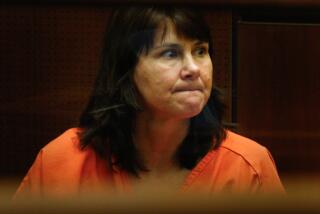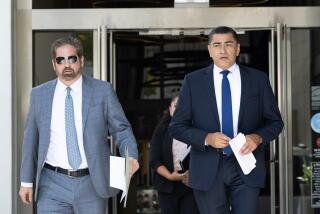Prosecution rests in retired LAPD detective’s murder trial
- Share via
Prosecutors in the murder trial of retired Los Angeles Police Department Det. Stephanie Lazarus rested their case Friday after three weeks of testimony, including that of a former FBI criminal profiler who said the killer staged part of the crime scene in an effort to throw off investigators.
Lazarus, a 25-year veteran of the LAPD who retired after her 2009 arrest, is accused of the Feb. 24, 1986, beating and shooting death of Sherri Rasmussen, a 29-year-old nurse who married a man Lazarus had dated.
Prosecutors allege that Lazarus, 51 — who was 26 at the time of the killing and had joined the LAPD a few years earlier — was infatuated with John Ruetten, now 53, and driven to kill by the jealousy she felt over his decision to marry someone else.
After grinding through weeks of detailed testimony that focused largely on DNA and other forensic evidence, prosecutors called their final witnesses on what happened to be the 26th anniversary of the killing.
One of the last to take the witness stand was Mark Safarik, who spent years profiling criminals for the FBI. Prosecutors hired Safarik, who now operates a consulting firm, to analyze evidence from the crime scene.
Rasmussen was discovered beaten and bloodied on the floor of the Van Nuys town house she shared with her new husband. She had been shot three times in the chest at close range and there was a human bite mark on one arm. Her head had been bludgeoned. Wounds on her wrists and cords on the floor indicated that she had been tied up. A thick quilt with bullet holes in it lay nearby.
With Rasmussen’s BMW missing and electronic equipment stacked on the floor of her home, the lead detective in the case theorized at the time that she had been killed when she came upon a burglar.
Safarik refuted that idea, saying he believed the killer had attempted to make the crime scene look like an interrupted burglary in order to confuse investigators.
Safarik said Rasmussen’s town house, with its alarm company sign on the door and position in clear view of other homes, was not a likely target for a burglar.
Also, he said, the intruder or intruders had not ransacked any part of the town house in search of valuables and had moved only two pieces of stereo equipment from a console that included several other pieces.
The decision to take the BMW, but not to fill it first with things from the house or to strip it down afterward of its valuable parts, also pointed to a faked burglary, Safarik said.
“What I saw was an attempt to create an illusion,” he said.
Lazarus’ attorney, Mark Overland, sparred strenuously with Safarik, trying to get him to admit his theory was based on unprovable assumptions of what had occurred.
Overland has indicated that when he begins his defense of Lazarus on Monday, he will try in part to convince jurors that the original burglary theory is a credible alternative to the story prosecutors want the jury to believe.
The prosecution’s case hinges heavily on saliva extracted from a bite mark on Sherri Rasmussen’s arm. Experts have testified that DNA tests on the saliva prove it came from Lazarus.
Despite repeated pleas by Sherri Rasmussen’s father to police, Lazarus was not considered a suspect at the time of the killing.
She became a focus of the investigation in 2009, when detectives reopened the case and interviewed family members, who mentioned the suspicions they had harbored for over two decades.
A highly secretive four-month investigation ensued and culminated with undercover officers following Lazarus for weeks. The officers eventually snatched a cup from which Lazarus had been drinking after she threw it away and used it to compare her saliva to the sample from the bite.
Lazarus has pleaded not guilty and has remained in custody on $10-million bail during the 2 1/2 years since her arrest.
More to Read
Sign up for Essential California
The most important California stories and recommendations in your inbox every morning.
You may occasionally receive promotional content from the Los Angeles Times.











